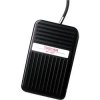ART makes a tube preamp that sell for $30 @ 'Guitar Center'. It will work nice; but you will need to use the unbalanced output (1/4 inch Tip/Ring/Sleeve plug; not the XLR/balanced output) to go to the radio. The mic to the preamp uses a XLR cable; a 6 ft cable will work best. You will have to figure out the pinout on the radio to get it right. The 'audio' wire into the radio is the "+" from the mic preamp output; and the PTT on the radio is where to wire the footswitch to. You might have to build/buy a footswitch. Easier to buy -than to build- that part.
Be careful with the output gain of the mic preamp into the radio. If it is too high; it may damage your radio's audio chip. Be careful...
Is that a 1/4'' stereo phone plug?
http://www.guitarcenter.com/ART-Tube-MP-Studio-Mic-Preamp-105798490-i1171932.gc
* Provides Superior Preamplification for: Microphones, Instruments and Line Level Sources
* Analog VU Meter
* OPL Output Protection Limiter
* Hand-Selected 12AX7A Vacuum Tube
* Variable Input and Output Gain Controls
* Provides over 70 dB of Gain
* +48 Phantom Power Switch
* Phase Reversal Switch
* XLR and 1/4" Inputs and Outputs
* Portable, All-Steel Construction
* Excellent as Tube DI
* Built-in Brickwall Limiting
* 20dB gain switch
ART Tube MP Studio Mic Preamp Specifications:
* Input Connections: XLR (balanced), ¼"TS (unbal)
* Output Connections: XLR (balanced), ¼"TS (unbal)
* Input Impedance XLR: ¼" 2K ohms, 840k ohms
* Output Impedance XLR: ¼" 600 ohms, 300ohms
* Maximum Input Level: XLR +14dBu
* Maximum Input Level, ¼" +22dBu
* Maximum Output Level: XLR +28dBu
* Maximum Output Level: " +22dBu
* CMRR >75dB (typical @ 1kHz)
* Frequency Response: 10Hz to 30kHz, ±5dB
* Dynamic Range: >100dB (20-20kHz) typical
* Total Harmonic Distortion (THD): <0.1% (typical)
* Maximum Gain:
* XLR to XLR 60dB (typical)
* ¼" to ¼" 44dB (typical)
* XLR to ¼" 54dB (typical)
* ¼" to XLR 50dB (typical)
* Equivalent Input Noise (EIN):
* XLR to XLR -129dBu (A weighted)
* ¼" to ¼" -105dBu (A weighted)
* Dimensions 5.0"H x 5.5" W x 2.0"H
* Weight 1.5 lbs.
ART Tube MP Studio Mic Preamp Includes:
power supply



